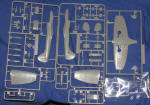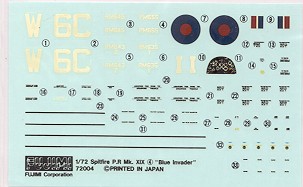
| KIT: | Fujimi 1/72 Spitfire PR. 19 |
| KIT #: | 72004 |
| PRICE: | $ |
| DECALS: | Four options |
| REVIEWER: | Scott Van Aken |
| NOTES: |

| HISTORY |
The Spitfire was not only an excellent short range fighter, but it was also one of the best photo recce aircraft that the RAF operated. This was especially true for tactical reconnaissance where speed was of major importance. Get the pictures and get back! The final version of the aircraft developed for reconnaissance duties was by general consent the best, the Spitfire PR19. This version saw extensive service after the war in a number of theatres. This version built on all the lessons learnt from previous aircraft, combining the wing of the PR 11 containing 66-gallon leading edge fuel tanks and potential camera installation and was powered by the 2000hp Griffon 65 series engine used in the Mk14. The total internal fuel capacity of the PR19 was 252 gallons, although there was the option of also carrying a 90 gal or 170 gal drop tank, the added drag virtually outweighed the benefit and it was rarely carried.
The camera installation was fairly similar to that used for the Mk 11. Within the fuselage were mounted various cameras, either two fanned or a single F52 36in vertical, two fanned F52 20in vertical or two fanned F24 14in vertical and one F24 14in or 8in oblique. The fuselage cameras were heated by warm air ducted from behind the starboard radiator. Additional cameras could also be carried in the wings in place of the inter-spar fuel tanks and these were also heated by warm ducted air. The installation of a full pressure cabin made life much more comfortable for the pilot during freezing high altitude, long endurance reconnaissance sorties that the type was occasionally tasked with performing. The last operational flight made by any RAF Spitfire was flown by a PR 19 over Malaya on 1 Apr 1954.
| THE KIT |
 Fujimi
has had a mixed reputation with its kits. Many of them are the finest
examples of the type around with good fit and quality molding. Some are
horrid, out of scale and not worth the plastic they are made with. Yet
others look great in the box, but when it comes time to build them, they
are filler nightmares. Not having built this particular kit, I can't tell
you which category it belongs. I can tell you that the surface detailing is
superb with fine and crisply molded engraved detailing. There are no sink
areas that I could easily spot. Only a tad of flash on a couple of parts
and ejector pin marks were only found on the back of the wheels, upper main
gear legs and the inside of the gear doors. All these should be relatively
simple to fix.
Fujimi
has had a mixed reputation with its kits. Many of them are the finest
examples of the type around with good fit and quality molding. Some are
horrid, out of scale and not worth the plastic they are made with. Yet
others look great in the box, but when it comes time to build them, they
are filler nightmares. Not having built this particular kit, I can't tell
you which category it belongs. I can tell you that the surface detailing is
superb with fine and crisply molded engraved detailing. There are no sink
areas that I could easily spot. Only a tad of flash on a couple of parts
and ejector pin marks were only found on the back of the wheels, upper main
gear legs and the inside of the gear doors. All these should be relatively
simple to fix.
The sprues are marked as 'Spitfire XIV', though some of the additional sections look to be peculiar to the PR.19. As you may expect, the builder is going to be doing a lot of drilling, scribing, and filling on this one. The various camera windows on the fuselage and lower wing will have to be opened up. On the upper wing surface, the gun access panels will need to be filled, some 'bumps' removed, and a couple of new panel lines scribed in place. What appears to be an anti-collision light on the box art, but a cooling scoop in the instructions that goes on the upper spine will need to be fabricated by the builder. The kit provides both 'clipped' and full wing tips, but only the full ones are appropriate. A long range fuel tank seems to be the only real option.
 Instructions
are quite good, providing all the needed info for doing the needed
conversion, for really, that is what you are doing; converting an FR.14
into a PR.19. Colors are given using Gunze paints and apparently PRU Blue
isn't in the catalogue as there is a mixture chart given for this. All the
four options are painted in overall PRU Blue. These planes were not very
colorful as Spitfires go, generally differing only in serial and perhaps an
aircraft number. No upper or lower wing roundels so the decal sheet isn't
missing anything. You have 'I' from 682 Sq in Italy during 1945 (the box
art plane), 6C*W from PRDU in England during 1947-48, 'Z' and 'Y' from 541
Sq in the UK during 1944. These planes both had D-Day stripes on the
fuselage. The decals themselves are well printed, thick and with white
markings that are actually closer to ivory. In other words, standard
Japanese kit decals.
Instructions
are quite good, providing all the needed info for doing the needed
conversion, for really, that is what you are doing; converting an FR.14
into a PR.19. Colors are given using Gunze paints and apparently PRU Blue
isn't in the catalogue as there is a mixture chart given for this. All the
four options are painted in overall PRU Blue. These planes were not very
colorful as Spitfires go, generally differing only in serial and perhaps an
aircraft number. No upper or lower wing roundels so the decal sheet isn't
missing anything. You have 'I' from 682 Sq in Italy during 1945 (the box
art plane), 6C*W from PRDU in England during 1947-48, 'Z' and 'Y' from 541
Sq in the UK during 1944. These planes both had D-Day stripes on the
fuselage. The decals themselves are well printed, thick and with white
markings that are actually closer to ivory. In other words, standard
Japanese kit decals.
| CONCLUSIONS |
For those of you used to Spit kits that have a dozen parts, this one will be a bit of a surprise. In order to do the usual multiple variations, Fujimi has made this one a bit fiddly. Separate wing tips, separate aft spine, an upper cowl that is in two halves and separate prop blades add to the parts count in this one. However, Fujimi has its heart in the right place and it definitely fills a gap in the long list of Spitfire variants.
Review kit courtesy of me and the sales table!
December 2004
If you would like your product reviewed fairly and quickly by a site that has nearly 300,000 visitors a month, please contact me or see other details in the Note to Contributors.